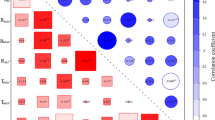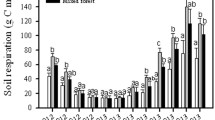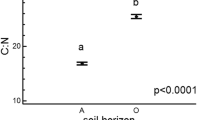Abstract
Purpose
The purposes of this study are to characterize the relationship between basal soil respiration at 0 °C (R0) and the temperature sensitivity (Q10) of soil respiration and climate, soil, and vegetation factors and to establish R0 and Q10 models.
Materials and methods
We compiled R0 and Q10 and variables (i.e., climate factors, soil properties, and vegetation characteristics) that were measured in various terrestrial ecosystems.
Results and discussion
The results showed that both R0 and Q10 could generally be fitted by a normal distribution curve across various ecosystems, but they varied greatly among the different ecosystems. The lowest median R0 and Q10 appeared in the desert, while the highest median R0 and Q10 appeared in the deciduous broad-leaf forest and deciduous needle-leaf forest ecosystems, respectively. The relationship between R0 and Q10 across different soil depths varied among the different ecosystems, with the highest and lowest R2 occurring in the cropland (R2 = 0.701) and evergreen needle-leaf forest (R2 = 0.095), respectively. A model that included Q10, fine root production and the ratio of soil organic carbon to total nitrogen (TN) explained 75.0% (R2 = 0.750) of the variation in R0, with a P value less than 0.001. Q10 was further expressed as a model (R2 = 0.663, P < 0.001) including annual precipitation, mean air temperature, TN, bulk density, and leaf area index.
Conclusions
Our R0 models can potentially be used to improve terrestrial carbon cycle models by considering the comprehensive effects of Q10 and soil and vegetation factors.





Similar content being viewed by others
Availability of data and material
All data generated or analyzed during this study are included in this published article and its supplementary materials.
Code availability
Not applicable.
References
Bahn M, Rodeghiero M, Anderson-Dun M, Dore S, Gimeno C, Drösler M, Williams M, Ammann C, Berninger F, Flechard C, Jones S, Balzarolo M, Kumar S, Newesely C, Priwitzer T, Raschi A, Siegwolf R, Susiluoto S, Tenhunen J, Wohlfahrt G, Cernusca A (2008) Soil respiration in European grasslands in relation to climate and assimilate supply. Ecosystems 11(8):1352–1367. https://doi.org/10.2307/40296374
Bahn M, Reichstein M, Davidson EA, Grunzweig J, Jung M, Carbone MS, Epron D, Misson L, Nouvellon Y, Roupsard O, Savage K, Trumbore SE, Gimeno C, Curiel Yuste J, Tang J, Vargas R, Janssens IA (2010) Soil respiration at meanannual temperature predicts annual total across vegetation types and biomes. Biogeosciences 7(7):2147–2157. https://doi.org/10.5194/bg-7-2147-2010
Bailey VL, Bond-Lamberty B, DeAngelis K, Grandy AS, Hawkes CV, Heckman K, Lajtha K, Phillips RP, Sulman BN, Todd-Brown KEO, Wallenstein MD (2018) Soil carbon cycling proxies: understanding their critical role in predicting climate change feedbacks. Glob Chang Biol 24(3):895–905. https://doi.org/10.1111/gcb.13926
Bekku Y, Koizumi H, Oikawa T, Iwaki H (1997) Examination of four methods for measuring soil respiration. Appl Soil Ecol 5(3):247–254. https://doi.org/10.1016/S0929-1393(96)00131-X
Bhanja SN, Wang J, Shrestha NK, Zhang X (2019) Modelling microbial kinetics and thermodynamic processes for quantifying soil CO2 emission. Atmos Environ 209:125–135. https://doi.org/10.1016/j.envpol.2019.01.062
Bosatta E, Ågren GI (1999) Soil organic matter quality interpreted thermodynamically. Soil Biol Biochem 31(3):1889–1891. https://doi.org/10.1016/S0038-0717(99)00105-4
Bradford MA (2013) Thermal adaptation of decomposer communities in warming soils. Front Microbiol 4:333. https://doi.org/10.3389/fmicb.2013.00333
Bradford MA, Mcculley RL, Crowther TW, Oldfield EE, Wood SA, Fierer N (2019) Cross-biome patterns in soil microbial respiration predictable from evolutionary theory on thermal adaptation. Nat Ecol Evol 3(2):223–231. https://doi.org/10.1038/s41559-018-0771-4
Bond-Lamberty B, Bailey VL, Chen M, Gough CM, Vargas R (2018) Globally rising soil heterotrophic respiration over recent decades. Nature 560(7716):80–83. https://doi.org/10.1038/s41586-018-0358-x
Burnham KP, Anderson DR, Huyvaert KP (2011) AIC model selection and multimodel inference in behavioral ecology. Behav Ecol Sociobiol 65(1):23–35. https://doi.org/10.1007/s00265-010-1029-6
Canadell JG, Le Quéré C, Raupach MR, Field CB, Buitenhuis ET, Ciais P, Conway TJ, Gillett NP, Houghton RA, Marland G (2007) Contributions to accelerating atmospheric CO2 growth from economic activity, carbon intensity, and efficiency of natural sinks. Proc Natl Acad Sci USA 104(47):18866–18870. https://doi.org/10.1073/pnas.0702737104
Chen S, Huang Y, Zou J, Shen Q, Hu Z, Qin Y, Chen H, Pan G (2010) Modeling interannual variability of global soil respiration from climate and soil properties. Agr Forest Meteorol 150(4):590–605. https://doi.org/10.1016/j.agrformet.2010.02.004
Chen S, Zou J, Hu Z, Lu Y (2020) Temporal and spatial variations in the mean residence time of soil organic carbon and their relationship with climatic, soil and vegetation drivers. Glob Planet Change 195:103359. https://doi.org/10.1016/j.gloplacha.2020.103359
Conant RT, Steinweg MJ, Haddix ML, Paul EA, Plante AF, Six J (2008a) Experimental warming shows that decomposition temperature sensitivity increases with soil organic matter recalcitrance. Ecology 89(9):2384–2391. https://doi.org/10.1890/08-0137.1
Conant RT, Drijber RA, Haddix ML, Parton WJ, Paul EA, Plante AF, Six J, Steinweg M (2008b) Sensitivity of organic matter decomposition to warming varies with its quality. Glob Chang Biol 14(4):868–877. https://doi.org/10.1111/j.1365-2486.2008.01541.x
Conant RT, Ryan MG, ÅgrenBirge GIHE, DavidsonEliasson EPE, Evans SE, Frey SD, Giardina CP, Hopkins FM, Hyvönen R, Kirschbaum MUF, Lavallee JM, Leifeld J, Parton WJ, Steinweg JM, Wallenstein MD, Wetterstedt JÅM, Bradford MA (2011) Temperature and soil organic matter decomposition rates - synthesis of current knowledge and a way forward. Glob Chang Biol 17(11):3392–3404. https://doi.org/10.1111/j.1365-2486.2011.02496.x
Cusack DF, Halterman SM, Tanner EVJ, Joseph WS, William H, Dietterich LH, Turner BL (2018) Decadal-scale litter manipulation alters the biochemical and physical character of tropical forest soil carbon. Soil Biol Biochem 124:199–209. https://doi.org/10.1016/j.soilbio.2018.06.005
Čater M, Darenova E, Simončič P (2020) Harvesting intensity and tree species affect soil respiration in uneven-aged Dinaric forest stands. Forest Ecol Manag 480:118638. https://doi.org/10.1016/j.foreco.2020.118638
Davidson EA, Janssens IA (2006) Temperature sensitivity of soil carbon decomposition and feedbacks to climate change. Nature 440(7081):165–173. https://doi.org/10.1038/nature04514
Davidson EA, Belk E, Boone RD (1998) Soil water content and temperature as independent or confounded factors controlling soil respiration in a temperature mixed hardwood forest. Glob Chang Biol 4(2):217–227. https://doi.org/10.1046/j.1365-2486.1998.00128.x
Davidson EA, Janssens IA, Luo Y (2006) On the variability of respiration in terrestrial ecosystems: moving beyond Q10. Glob Chang Biol 12(2):154–164. https://doi.org/10.1111/j.1365-2486.2005.01065.x
Ding J, Chen L, Zhang B, Liu L, Yang G, Fang K, Chen Y, Li F, Kou D, Ji C, Luo Y, Yang Y (2016) Linking temperature sensitivity of soil CO2 release to substrate, environmental, and microbial properties across alpine ecosystems. Global Biogeochem Cy 30(9):1310–1323. https://doi.org/10.1002/2015GB005333
Doetterl S, Stevens A, Six J, Merckx R, Van Oost K, Casanova MA, Casanova-Katny A, Muñoz C, Boudin M, Zagal E, Boeckx P (2015) Soil carbon storage controlled by interactions between geochemistry and climate. Nat Geosci 8(10):780–783. https://doi.org/10.1038/s41467-021-23676-x
Dusza Y, Sanchez-Caete EP, Le Galliard J-F, Ferrière R, Chollet S, Hansart A, Juarez S, Dontsova K, van Haren J, Troch P, Pavao-Zuckerman M, Hamerlynck E, Barron-Gafford GA (2020) Biotic soil-plant interaction processes explain most of hysteretic soil CO2 efflux response to temperature in cross-factorial mesocosm experiment. Sci Rep 10(529):905. https://doi.org/10.1038/s41598-019-55390-6
February E, Pausch J, Higgins SI (2020) Major contribution of grass roots to soil carbon pools and CO2 fluxes in a mesic savanna. Plant Soil 454(1–2):207–215. https://doi.org/10.1007/s11104-020-04649-3
Feng J, Wang J, Song Y, Zhu B (2018) Patterns of soil respiration and its temperature sensitivity in grassland ecosystems across China. Biogeosciences 15(17):5329–5341. https://doi.org/10.5194/bg-15-5329-2018
Fierer N, Craine JM, Mclauchlan KK, Schimel JP (2005) Litter quality and the temperature sensitivity of decomposition. Ecology 86(2):320–326. https://doi.org/10.1890/04-1254
Fierer N, Colman BP, Schimel JP, Jackson RB (2006) Predicting the temperature dependence of microbial respiration in soil: a continental-scale analysis. Global Biogeochem Cy 20(3):GB3026. https://doi.org/10.1029/2005GB002644
Franco-Luesma S, Caveroa J, Plaza-Bonilla D, Cantero-Martínez C, Arrúea JL, Álvaro-Fuentesa J (2020) Tillage and irrigation system effects on soil carbon dioxide (CO2) and methane (CH4) emissions in a maize monoculture under Mediterranean conditions. Soil till Res 196:104488. https://doi.org/10.1016/j.still.2019.104488
Friedlingstein P, Andrew RM, Rogelj J, Peters GP, Canadell JG, Knutti R, Luderer G, Raupach MR, Schaeffer M, van Vuuren DP, Le Quéré C (2014) Persistent growth of CO2 emissions and implications for reaching climate targets. Nat GeoSci 7(10):709–715. https://doi.org/10.1038/ngeo2248
Giardina CP, Ryan MG (2000) Evidence that decomposition rates of organic carbon in mineral soil do not vary with temperature. Nature 404(6780):858–861. https://doi.org/10.1038/35009076
Gutierrez-Giron A, Diaz-Pines E, Rubio A, Gavilan RG (2015) Both altitude and vegetation affect temperature sensitivity of soil organic matter decomposition in Mediterranean high mountain soils. Geoderma 237:1–8. https://doi.org/10.1016/j.geoderma.2014.08.005
Haaf D, Six J, Doetterl S (2021) Global patterns of geo-ecological controls on the response of soil respiration to warming. Nat Clim Change 11(7):623–627. https://doi.org/10.1038/s41558-021-01068-9
Haghighi E, Damm A, Jiménez-Martínez J (2021) Root hydraulic redistribution underlies the insensitivity of soil respiration to combined heat and drought. Appl Soil Ecol 167(2):104155. https://doi.org/10.1016/j.apsoil.2021.104155
Hashimoto S (2005) Q10 values of soil respiration in Japanese forests. J for Res 10:409–413. https://doi.org/10.1007/s10310-005-0164-9
Hereş A, Braga C, Petritan AM, Petritan IC, Yuste JC (2021) Spatial variability of soil respiration (Rs) and its controls are subjected to strong seasonality in an even‐aged European beech (Fagus sylvatica L.) stand. Eur J Soil Sci 72(5):1988–2005. https://doi.org/10.1111/ejss.13116
Hursh A, Ballantyne A, Cooper L, Maneta M, Kimball J, Watts J (2017) The sensitivity of soil respiration to soil temperature, moisture, and carbon supply at the global scale. Glob Chang Biol 23(5):2090–2103. https://doi.org/10.1111/gcb.13489
Janssen PHM, Heuberger PSC (1995) Calibration of process oriented models. Ecol Model 83(1–2):55–66. https://doi.org/10.1016/0304-3800(95)00084-9
Jenkinson DS, Adams DE, Wild A (1991) A model estimates of CO2 emissions from soil in response to global warming. Nature 351(6324):304–306. https://doi.org/10.1038/351304a0
Jian J, Steele MK, Zhang L, Bailey V, Zheng J, Patel K, Bond-Lamberty BP (2021) On the use of air temperature and precipitation as surrogate predictors in soil respiration modeling. Eur J Soil Sci. https://doi.org/10.1111/ejss.13149
Johnston AS, Sibly RM (2018) The influence of soil communities on the temperature sensitivity of soil respiration. Nat Ecol Evol 2(10):1597–1602. https://doi.org/10.1038/s41559-018-0648-6
Karhu K, Fritze H, Hämäläinen K, Vanhala P, Jungner H, Oinonen M, Sonninen E, Tuomi M, Spetz P, Kitunen V, Liski J (2010) Temperature sensitivity of soil carbon fractions in boreal forest soil. Ecology 91(2):370–376. https://doi.org/10.1890/09-0478.1
Knorr W, Prentice IC, House JI, Holland EA (2005) Long-term sensitivity of soil carbon turnover to warming. Nature 433(7023):298–301. https://doi.org/10.1038/nature03226
Kramer MG, Chadwick OA (2018) Climate-driven thresholds in reactive mineral retention of soil carbon at the global scale. Nat Clim Change 8(12):1104–1108. https://doi.org/10.1038/s41558-018-0341-4
Lenton TM, Huntingford C (2003) Global terrestrial carbon storage and uncertainties in its temperature sensitivity examined with a simple model. Glob Change Biol 9(10):1333–1352. https://doi.org/10.1046/j.1365-2486.2003.00674.x
Liski J, Ilvesniemi H, Makela A, Westman CJ (1999) CO2 emissions from soil in response to climatic warming are overestimated—the decomposition of old soil organic matter is tolerant of temperature. Ambio 28(2):171–174
Lloyd J, Taylor JA (1994) On the temperature-dependence of soil respiration. Funct Ecol 8(3):315–323. https://doi.org/10.2307/2389824
Luan J, Liu S, Wang J, Chang SX, Liu X, Lu H, Wang Y (2018) Tree species diversity promotes soil carbon stability by depressing the temperature sensitivity of soil respiration in temperate forests. Sci Total Environ 645:623–629. https://doi.org/10.1016/j.scitotenv.2018.07.036
Malcolm GM, López-Gutiérrez JC, Koide RT (2009) Temperature sensitivity of respiration differs among forest floor layers in a Pinus resinosa plantation. Soil Biol Biochem 41:1075–1079. https://doi.org/10.1016/j.soilbio.2009.02.011
Malek I, Meryem B, Posta K, Fóti S, Pintér K, Nagy Z, Balogh J (2021) Responses of soil respiration to biotic and abiotic drivers in a temperate cropland. Eurasian Soil Sci 54(7):1038–1048. https://doi.org/10.1134/S1064229321070097
Melillo JM, Frey SD, Deangelis KM, Werner WJ, Bernard MJ, Bowles FP, Pold G, Knorr MA, Grandy AS (2017) Long-term pattern and magnitude of soil carbon feedback to the climate system in a warming world. Science 358(6359):101–105. https://doi.org/10.1126/science.aan2874
Meyer N, Welp G, Amelung W (2018) The temperature sensitivity (Q10) of soil respiration: controlling factors and spatial prediction at regional scale based on environmental soil classes. Glob Biogeochem Cy 32(2):306–323. https://doi.org/10.1002/2017GB005644
Monson RK, Lipson DL, Burns SP, Turnipseed AA, Delany AC, Williams MW, Schmidt SK (2006) Winter forest soil respiration controlled by climate and microbial community composition. Nature 439(7077):711–714. https://doi.org/10.1038/nature04555
Morote FAG, Abellán MA, Rubio E, Anta IP, Serrano FRL (2021) Stem CO2 efflux as an indicator of forests’ productivity in Relict Juniper Woodlands (Juniperus thurifera L.) of southern Spain. Forests 12(10):1340. https://doi.org/10.3390/f12101340
Mujica C, Bea SA, Jobbágy E (2021) Modeling soil chemical changes induced by grassland afforestation in a sedimentary plain with shallow groundwater. Geoderma 400:115158. https://doi.org/10.1016/j.geoderma.2021.115158
Nghalipo EN, Throop H (2021) Vegetation patch type has a greater influence on soil respiration than does fire history on soil respiration in an arid broadleaf savanna woodland, central Namibia. J Arid Environ 193:104577. https://doi.org/10.1016/j.jaridenv.2021.104577
Nishimura S, Yonemura S, Sawamoto T, Shirato Y, Akiyama H, Sudo S, Yagi K (2008) Effect of land use change from paddy rice cultivation to upland crop cultivation on soil carbon budget of a cropland in Japan. Agric Ecosyst Environ 125(1):9–20. https://doi.org/10.1016/j.agee.2007.11.003
Nottingham TA, Meir P, Velasquez E, Turner BL (2020) Soil carbon loss by experimental warming in a tropical forest. Nature 584(7820):234–237. https://doi.org/10.1038/s41586-020-2566-4
Pearl J (2000) Causality: models, reasoning, and inference. Cambridge University Press
Peng S, Piao S, Wang T, Sun J, Shen Z (2009) Temperature sensitivity of soil respiration in different ecosystems in China. Soil Biol Biochem 41(5):1008–1014. https://doi.org/10.1016/j.soilbio.2008.10.023
Pineiro G, Perelman S, Guerschman JP, Paruelo JM (2008) How to evaluate models: observed vs. predicted or predicted vs. observed? Ecol Model 216(3–4):316–322. https://doi.org/10.1016/j.ecolmodel.2008.05.006
Phillips CL, Bond-Lamberty B, Desai AR, Lavoie M, Risk D, Tang J, Todd-Brown K, Vargas R (2016) The value of soil respiration measurements for interpreting and modeling terrestrial carbon cycling. Plant Soil 413(1):1–25. https://doi.org/10.1007/s11104-016-3084-x
Raich JW, Schlesinger WH (1992) The global carbon dioxide flux in soil respiration and its relationship to vegetation and climate. Tellus B 44(2):81–99. https://doi.org/10.1034/j.1600-0889.1992.t01-1-00001.x
Raich JW (1998) Aboveground productivity and soil respiration in three Hawaiian rain forests. Forest Ecol Manag 107(1–3):309–318. https://doi.org/10.1016/S0378-1127(97)00347-2
Reichstein M, Bednorz F, Broll G, Katterer T (2000) Temperature dependence of carbon mineralisation: conclusions from a longterm incubation of subalpine soil samples. Soil Bio Biochem 32(7):947–958. https://doi.org/10.1016/S0038-0717(00)00002-X
Ribeiro NS, Saatchi SS, Shugart HH, Washington-Allen RA (2008) Aboveground biomass and leaf area index (LAI) mapping for Niassa Reserve, northern Mozambique. J Geophys Res-Biogeo 113(G3). https://doi.org/10.1029/2007JG000550
Rodtassana C, Unawong W, Yaemphum S, Chanthorn W, Chawchai S, Nathalang A, Brockelman WY, Tor-ngern P (2021) Different responses of soil respiration to environmental factors across forest stages in a Southeast Asian forest. Ecol Evol 11(11):15430–15443. https://doi.org/10.1002/ece3.8248
Rustad LE, Campbell JL, Marion GM, Norby RJ, Mitchell MJ, Hartley AE, Cornelissen JHC, Gurevitch J (2001) A meta-analysis of the response of soil respiration, net nitrogen mineralization, and above-ground plant growth to experimental ecosystem warming. Oecologia 126(4):543–562. https://doi.org/10.1007/s004420000544
Schwarz G (1978) Estimating the dimension of a model. Ann Stat 6(2):461–464. https://doi.org/10.1214/aos/1176344136
Shi P, Qin Y, Liu Q, Zhu T, Li Z, Li P, Ren Z, Liu Y, Wang F (2019) Linking temperature sensitivity of soil CO2 release to substrate, environmental, and microbial properties across alpine ecosystems. Sci Total Environ 707:135507. https://doi.org/10.1016/j.scitotenv.2019.135507
Schimel D, Melillo JM, Tian H, McGuire D, Kicklighter D, Kittel T, Rosenbloom N, Running S, Thornton P, Ojima D, Parton W, Kelly R, Sykes M, Neilson R, Rizzo B (2000) Contribution of increasing CO2 and climate to carbon storage by ecosystems in the United States. Science 287(5460):2004–2006. https://doi.org/10.1126/science.287.5460.2004
Stell E, Warner D, Jian J, Bond-Lamberty B, Vargas R (2021) Spatial biases of information influence global estimates of soil respiration: how can we improve global predictions? Glob Change Biol 27(16):3923–3938. https://doi.org/10.1111/gcb.15666
Stone BW, Li J, Koch BJ, Blazewicz S J, Dijkstra P, Hayer M, Hofmockel K S, Liu XA, Mau RL, Morrissey E M, Pett-Ridge J, Schwartz E, Hungate B A (2021) Nutrients cause consolidation of soil carbo flux to small proportion of bacterial community. Nat Commun 12(1):3381. https://doi.org/10.1038/s41467-021-23676-x
Wang Y, Wang Y (2003) Quick measurement of CH4, CO2 and N2O emissions from a short-plant ecosystem. Adv Atmos Sci 20(5):842–844. https://doi.org/10.1007/BF02915410
Wang X, Piao S, Ciais P, Janssens IA, Reichstein M, Peng S, Wang T (2010) Are ecological gradients in seasonal Q10 of soil respiration explained by climate or by vegetation seasonality? Soil Biol Biochem 42(10):1728–1734. https://doi.org/10.1016/j.soilbio.2010.06.008
Wang R, Wang Z, Sun Q, Zhao M, Du L, Wu D, Li R, Gao X, Guo S (2016) Effects of crop types and nitrogen fertilization on temperature sensitivity of soil respiration in the semi-arid Loess Plateau. Soil Till Res 163:1–9. https://doi.org/10.1016/j.still.2016.05.005
Wang Y, Liu S, Luan J, Chen C, Cai C, Zhou F, Di Y, Gao X (2021) Nitrogen addition exacerbates the negative effect of through fall reduction on soil respiration in a bamboo fore. Forests 12(6):724. https://doi.org/10.3390/f12060724
Xu X, Luo Y, Zhou J (2012) Carbon quality and the temperature sensitivity of soil organic carbon decomposition in a tallgrass prairie. Soil Biol Biochem 50:142–148. https://doi.org/10.1016/j.soilbio.2012.03.007
Xu Z, Tang S, Xiong L, Yang W, Yin H, Tu L, Wu F, Chen L, Tan B (2015) Temperature sensitivity of soil respiration in China’s forest ecosystems: patterns and controls. Appl Soil Ecol 93:105–110. https://doi.org/10.1016/j.apsoil.2015.04.008
Yu S, Chen Y, Zhao J, Fu S, Li Z, Xia H, Zhou L (2017) Temperature s ensitivity of total soil respiration and its heterotrophic and autotrophic components in six vegetation types of subtropical China. Sci Total Environ 607–608:160–167. https://doi.org/10.1016/j.scitotenv.2017.06.194
Zheng Z, Yu G, Fu Y, Wang Y, Sun X, Wang Y (2009) Temperature sensitivity of soil respiration is affected by prevailing climatic conditions and soil organic carbon content: a trans-China based case study. Soil Biol Biochem 41(7):1531–1540. https://doi.org/10.1016/j.soilbio.2009.04.013
Acknowledgements
We gratefully thank the University of Delaware for providing global meteorological data, i.e., the precipitation and air temperature database.
Funding
Our study was financially supported by the National Natural Science Foundation of China (NSFC 41775151).
Author information
Authors and Affiliations
Corresponding author
Ethics declarations
Ethics approval
This study does not involve animals.
Consent to participate
This study does not involve human participants.
Conflict of interest
The authors declare no competing interests.
Additional information
Responsible editor: Weixin Ding
Publisher's Note
Springer Nature remains neutral with regard to jurisdictional claims in published maps and institutional affiliations.
Supplementary Information
Below is the link to the electronic supplementary material.
Rights and permissions
About this article
Cite this article
Chen, S., Zhang, M., Zou, J. et al. Relationship between basal soil respiration and the temperature sensitivity of soil respiration and their key controlling factors across terrestrial ecosystems. J Soils Sediments 22, 769–781 (2022). https://doi.org/10.1007/s11368-021-03130-7
Received:
Accepted:
Published:
Issue Date:
DOI: https://doi.org/10.1007/s11368-021-03130-7




